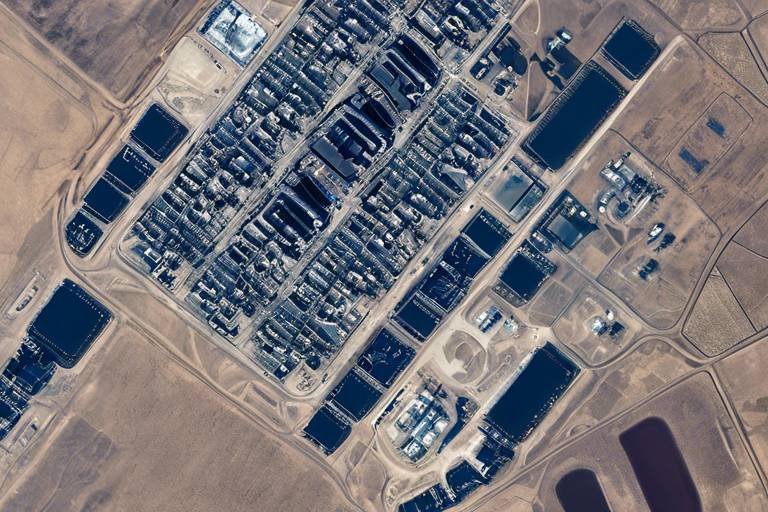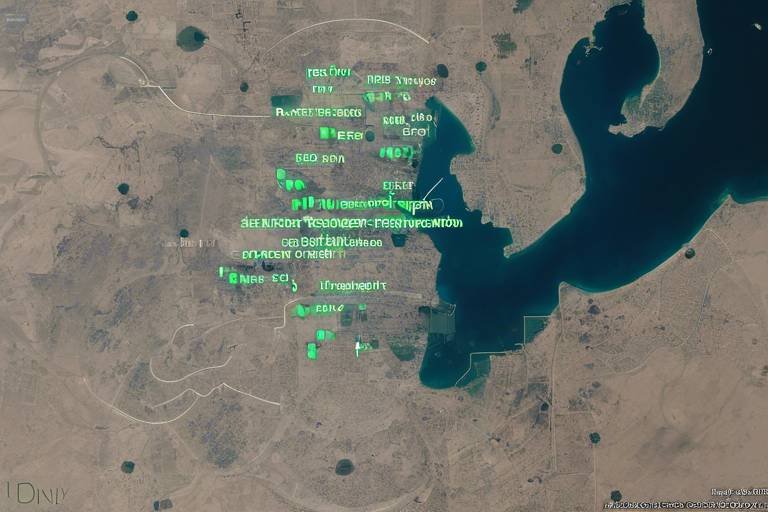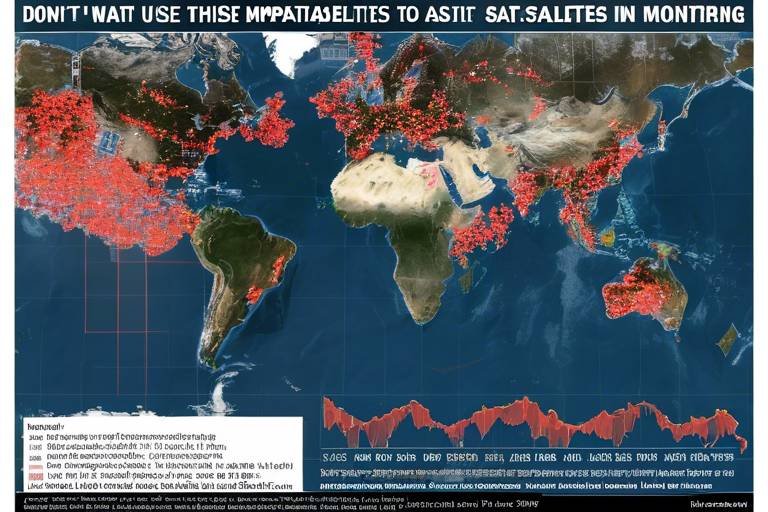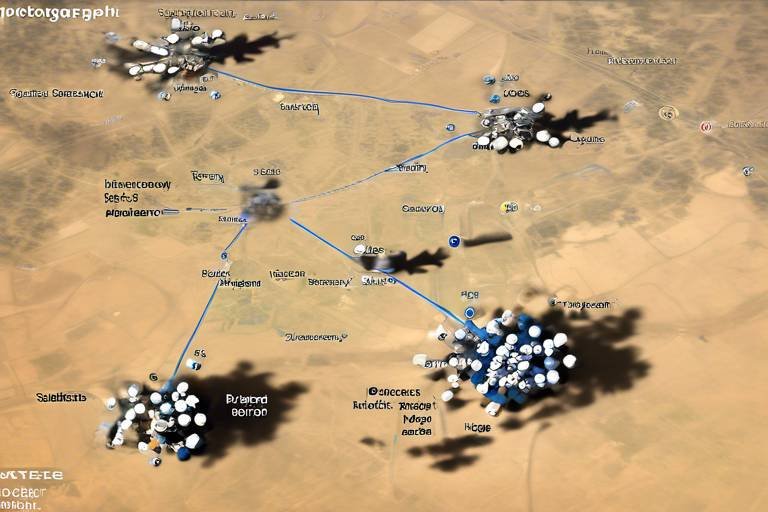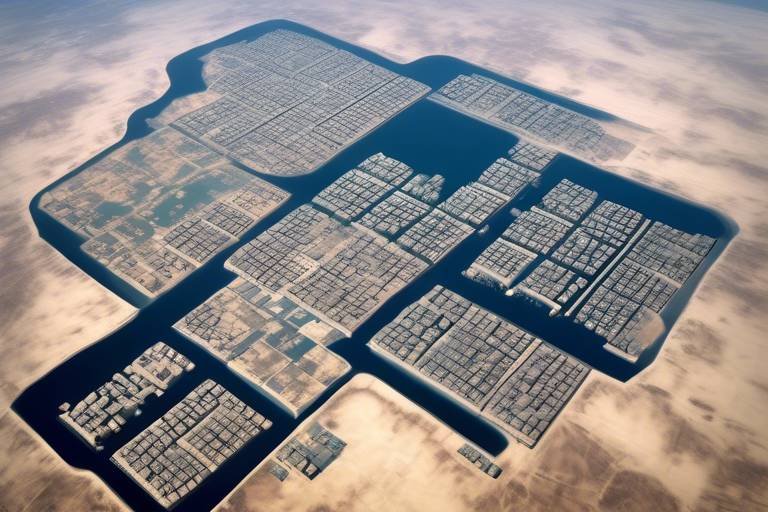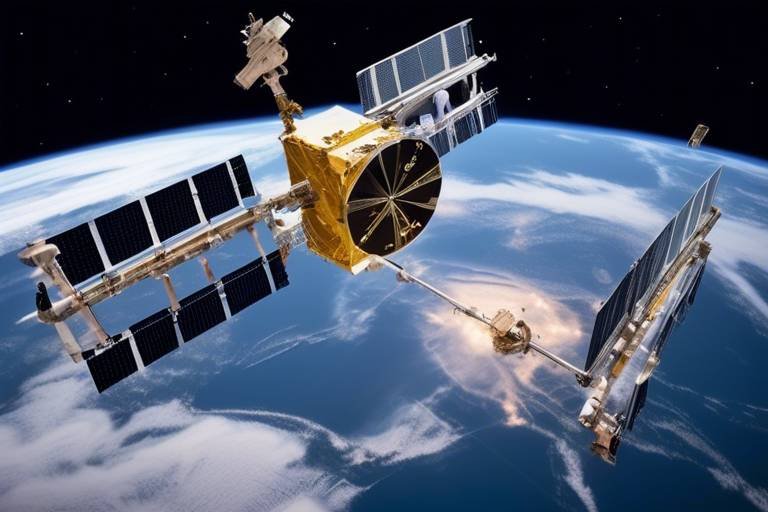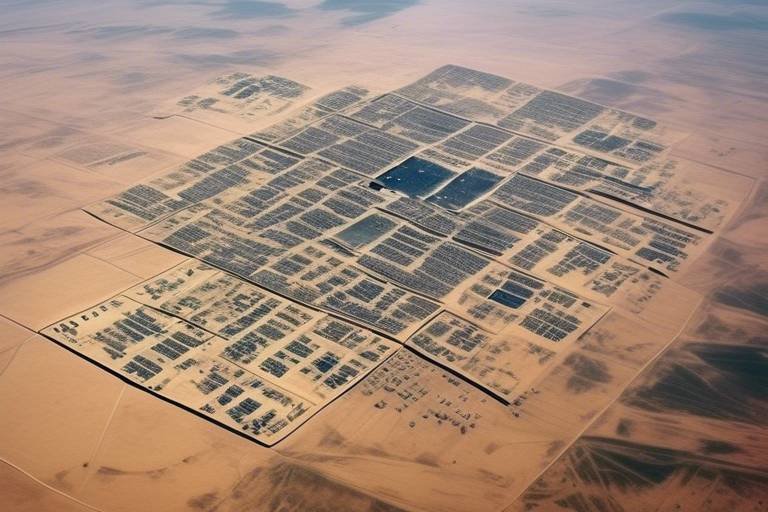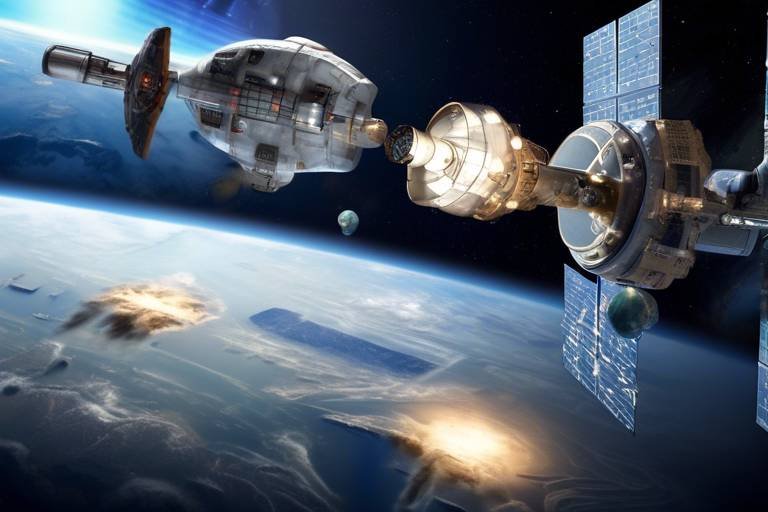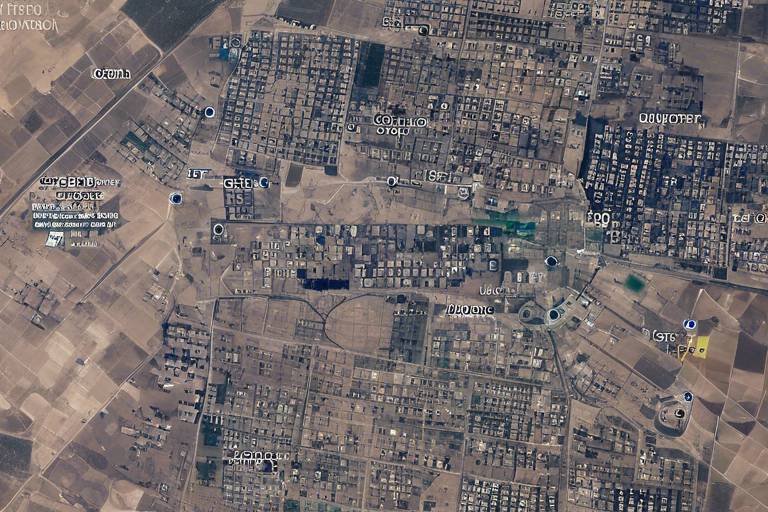How Satellites Aid in Securing Critical Military Infrastructure
In today's fast-paced world, satellites have become indispensable tools for military operations, playing a crucial role in securing critical infrastructure. Imagine a vast network of eyes in the sky, constantly monitoring and gathering information from around the globe. This is not just a sci-fi fantasy; it's the reality of modern military strategy. Satellites enhance security through various applications, including surveillance, communication, navigation, and intelligence gathering. With the ability to operate in real-time, they provide military forces with a significant advantage, ensuring that they are always one step ahead of potential threats. But how exactly do these technological marvels work to protect military assets? Let's dive deeper into the fascinating world of satellite technology and its pivotal role in military operations.
Satellite surveillance techniques have revolutionized military operations by offering unprecedented capabilities. These systems provide real-time imagery and data, enabling forces to monitor potential threats and gather intelligence from vast areas without the need for physical presence. Imagine being able to observe enemy movements across a battlefield or monitor strategic locations without ever stepping foot on the ground. The power of satellite surveillance lies in its ability to cover extensive territories, providing a bird's-eye view that is crucial for effective military planning.
Moreover, satellite surveillance can be categorized into various techniques, such as:
- Optical Imaging: Captures high-resolution images of the Earth's surface, allowing for detailed analysis of enemy positions.
- Infrared Imaging: Detects heat signatures, making it easier to spot vehicles or personnel even in low visibility conditions.
- Radar Imaging: Utilizes radio waves to create images of the terrain, which is particularly useful in adverse weather conditions.
Communication is the backbone of any military operation, and military satellites are equipped with advanced communication systems that ensure secure and reliable data transmission. These systems facilitate seamless coordination and command among different military units operating in diverse environments. Imagine a general communicating with troops stationed miles away, receiving real-time updates and issuing commands without any delays. This level of connectivity is vital for operational success.
To safeguard sensitive military information, secure data transmission protocols are critical. These protocols protect against interception and unauthorized access, ensuring that communications remain confidential and reliable. In a world where cyber threats are increasingly prevalent, the integrity of military communications is paramount.
Various encryption methods are employed in military satellite communications to enhance security. These methods ensure that even if data is intercepted, it remains unreadable to unauthorized entities. For instance, Advanced Encryption Standard (AES) is widely used due to its robust security features, making it a preferred choice for military applications.
Additionally, redundancy measures in satellite communication systems ensure continuous operation even during failures. This reliability is crucial for maintaining command and control in military operations. By having backup systems in place, military forces can rest assured that their communication lines will remain open, even in the face of unexpected challenges.
GPS technology is vital for military navigation, providing accurate positioning data that assists in mission planning, troop movements, and operational efficiency across diverse terrains. Picture a soldier navigating through dense forests or urban landscapes with pinpoint accuracy, thanks to satellite-guided navigation. This capability not only enhances operational effectiveness but also reduces the risk of getting lost in unfamiliar territories.
Satellites play a significant role in intelligence gathering, collecting data that is analyzed to inform military strategies and operations. This capability enhances situational awareness and decision-making. By leveraging satellite data, military planners can make informed decisions that could mean the difference between success and failure on the battlefield.
Imagery analysis techniques utilize satellite images to assess enemy movements and infrastructure, enabling military planners to make informed decisions based on visual intelligence. The ability to analyze these images quickly and accurately is essential in developing effective strategies.
Integrating satellite data with ground intelligence creates a comprehensive operational picture, enhancing the effectiveness of military strategies and improving response times in critical situations. This synergy ensures that military leaders have access to the most accurate and up-to-date information available.
Despite their advantages, military satellites face various security challenges, including cyber threats, jamming, and physical attacks. These challenges necessitate robust measures to safeguard their integrity and functionality. It's crucial to stay ahead of evolving threats to ensure that these vital assets remain operational.
Countermeasures against cyber threats involve implementing advanced cybersecurity protocols to protect satellite systems from hacking attempts and unauthorized access that could compromise military operations. As technology evolves, so too must the strategies to defend against potential breaches.
Physical security measures for satellites include protective strategies at ground stations and in space to prevent sabotage or destruction, ensuring the continued operation of these critical assets. This multi-layered approach to security is essential in maintaining the integrity of military satellite operations.
Q: How do satellites improve military communication?
A: Satellites provide secure and reliable communication channels, allowing military units to coordinate effectively across vast distances.
Q: What are the main uses of satellite imagery in military operations?
A: Satellite imagery is used for surveillance, reconnaissance, and intelligence analysis, helping military planners make informed decisions.
Q: What challenges do military satellites face?
A: Military satellites face challenges such as cyber threats, physical attacks, and jamming, necessitating robust security measures.
Satellite Surveillance Techniques
Satellite surveillance techniques have truly transformed the landscape of military operations. Imagine having the ability to monitor vast stretches of land from the comfort of a control room, without ever setting foot on the battlefield. This is the power of satellite technology, providing real-time imagery and data that empowers military forces to keep a vigilant eye on potential threats. With the advancements in satellite technology, military planners can now gather intelligence from remote locations, ensuring that they are always a step ahead of adversaries.
One of the most significant advantages of satellite surveillance is its ability to deliver high-resolution images and data analytics. These satellites can capture detailed visual information, allowing military analysts to assess enemy movements, infrastructure, and even troop deployments. For instance, consider the difference between using a drone that can only cover a limited area versus a satellite that can monitor an entire region. The latter provides a comprehensive view, making it easier to identify patterns and anomalies that could indicate hostile activity.
Moreover, the integration of synthetic aperture radar (SAR) technology enables satellites to capture images regardless of weather conditions or time of day. This capability is crucial for military operations, as it ensures that surveillance can continue uninterrupted, even during adverse weather or nighttime hours. The data collected can then be processed and analyzed to produce actionable intelligence that informs strategic decisions.
Additionally, satellites can operate in various orbits, each tailored for specific surveillance needs. For example, low Earth orbit (LEO) satellites provide rapid revisit times, allowing for near real-time monitoring, while geostationary satellites maintain a constant position relative to the Earth's surface, offering persistent coverage of critical areas. This versatility in satellite deployment enhances the military's ability to respond swiftly to emerging threats.
In conclusion, the importance of satellite surveillance techniques in military operations cannot be overstated. They offer unparalleled capabilities in monitoring, intelligence gathering, and strategic planning. As technology continues to evolve, we can expect even greater advancements in satellite surveillance, further solidifying its role as a cornerstone of modern military operations.
Communication Systems in Military Satellites
When it comes to military operations, effective communication is not just important; it's absolutely crucial. Military satellites are equipped with advanced communication systems that ensure secure and reliable data transmission. Imagine being in the middle of a high-stakes operation where every second counts. The ability to communicate seamlessly across different units can mean the difference between mission success and failure. These satellites facilitate coordination among various military branches, enabling them to operate efficiently in diverse operational environments.
One of the standout features of military satellite communication systems is their ability to transmit data over vast distances. Unlike traditional communication systems that might falter in remote areas, military satellites can provide coverage even in the most challenging terrains. This capability allows military personnel to remain connected and informed, no matter where they are stationed. With the integration of satellite communication, commanders can make real-time decisions based on accurate and timely information.
Moreover, military communication systems are designed with various layers of security to protect sensitive information. This is where secure data transmission protocols come into play. These protocols are essential for safeguarding communications against interception and unauthorized access. Without these measures, critical military information could easily fall into the wrong hands, jeopardizing not just missions but also the safety of personnel.
Secure data transmission protocols are the backbone of military satellite communications. They ensure that even if data is intercepted, it remains unreadable to unauthorized entities. These protocols utilize various encryption methods, which we will delve into shortly. The importance of these protocols cannot be overstated; they act as the military’s digital fortress, defending against potential breaches.
Encryption methods employed in military satellite communications are sophisticated and constantly evolving. Some of the common encryption techniques include:
- Symmetric Encryption: This method uses the same key for both encryption and decryption, making it efficient for real-time communication.
- Asymmetric Encryption: Utilizing a pair of keys (public and private), this method enhances security by ensuring that only the intended recipient can decrypt the message.
- Quantum Encryption: An emerging technology that leverages the principles of quantum mechanics, providing a level of security that is virtually unbreakable.
These encryption methods ensure that even if data is intercepted, it remains a jumbled mess to anyone without the correct decryption key.
Another critical aspect of military satellite communication systems is redundancy. Redundancy measures ensure continuous operation even during failures, which is essential for maintaining command and control in military operations. Imagine a scenario where communication is lost during a critical mission; the consequences could be dire. To prevent such situations, military satellites are designed with backup systems that automatically engage in case of a primary system failure. This reliability is a game-changer, providing military forces with the confidence that they can operate effectively, regardless of unforeseen circumstances.
In summary, communication systems in military satellites are a blend of advanced technology, robust security measures, and reliable infrastructure. They ensure that military personnel can communicate effectively and securely, allowing for enhanced operational efficiency and mission success.
Secure Data Transmission Protocols
When it comes to military operations, the importance of cannot be overstated. These protocols act as the backbone of communication systems, ensuring that sensitive information remains protected from prying eyes. Imagine a high-stakes game of chess where every move is crucial; in the military arena, the strategies are just as delicate, and the need for confidentiality is paramount. Without robust protocols, the risk of interception and unauthorized access could jeopardize entire missions.
At the core of these secure protocols is a combination of advanced encryption techniques and stringent authentication measures. Encryption transforms readable data into a scrambled format, rendering it useless to anyone who might intercept it. This is akin to sending a message in a language only the intended recipient understands. For example, the use of Advanced Encryption Standard (AES) is prevalent in military communications, providing a strong layer of security that is difficult to breach.
Moreover, authentication protocols ensure that the parties involved in the communication are who they claim to be. This is crucial in preventing impersonation attacks, where an adversary might attempt to mimic a legitimate user to gain access to sensitive information. Techniques like Public Key Infrastructure (PKI) are commonly employed to verify identities and establish trust between communicating entities.
To illustrate how these protocols work in practice, consider the following table that outlines some key components:
| Protocol | Description | Purpose |
|---|---|---|
| AES | Symmetric encryption standard | Secures data by encrypting it with a secret key |
| PKI | Framework for managing digital certificates | Ensures the authenticity of users and devices |
| SSL/TLS | Protocols for secure internet communication | Encrypts data during transmission over networks |
In addition to encryption and authentication, the implementation of redundancy measures plays a critical role in maintaining data integrity. Redundancy ensures that even if one transmission route is compromised, alternate pathways can be utilized to deliver the message securely. This is similar to having multiple escape routes in case of an emergency; it provides an added layer of reassurance that communication can continue uninterrupted.
In conclusion, secure data transmission protocols are essential in safeguarding military communications. They not only protect sensitive information from interception but also ensure that the integrity of the communication process is maintained. As technology evolves, so too must these protocols, adapting to new threats and challenges in the ever-changing landscape of military operations.
- What are secure data transmission protocols? They are methods used to protect sensitive information during communication, ensuring confidentiality and integrity.
- Why is encryption important? Encryption transforms readable data into an unreadable format, protecting it from unauthorized access.
- How does authentication work? Authentication verifies the identities of the parties involved in communication to prevent impersonation attacks.
- What is redundancy in communication? Redundancy refers to having multiple communication pathways to ensure that messages can still be transmitted even if one route is compromised.
Encryption Methods Used
In the realm of military satellite communications, encryption methods serve as the backbone of data security, ensuring that sensitive information remains shielded from prying eyes. These methods are not just technical jargon; they are essential tools that protect the integrity of military operations. Imagine sending a letter in the mail but having it locked in a vault that only you and the recipient can access. That's precisely what encryption does for military communications.
One of the most widely used encryption techniques is Advanced Encryption Standard (AES). AES operates on the principle of transforming plaintext into ciphertext through a series of complex algorithms. This method is favored for its speed and security, making it ideal for real-time communications. In military operations, where every second counts, AES ensures that messages are transmitted quickly without compromising their confidentiality.
Another notable method is Public Key Infrastructure (PKI), which employs a pair of keys—one public and one private. The public key encrypts the data, while the private key decrypts it. This dual-key system provides an additional layer of security, as even if the public key is intercepted, the data remains inaccessible without the private key. Think of it as having a combination lock: only the person with the combination can unlock it, no matter how many people know the lock's existence.
Moreover, military satellites often utilize frequency hopping spread spectrum (FHSS) technology, which changes the frequency of the signal at rapid intervals. This technique makes it exceedingly difficult for adversaries to intercept and decipher communications. It's akin to a game of hide and seek, where the signal constantly moves, leaving potential intruders guessing and scrambling to keep up.
To demonstrate the effectiveness of these encryption methods, consider the following table, which outlines their key features:
| Encryption Method | Key Features | Use Case |
|---|---|---|
| AES | Fast, secure, symmetric encryption | Real-time data transmission |
| PKI | Asymmetric encryption with public/private keys | Secure email and data exchange |
| FHSS | Rapid frequency changes to avoid interception | Secure voice and data communications |
In summary, the use of these encryption methods is paramount in safeguarding military satellite communications. They not only protect against unauthorized access but also ensure that critical information remains confidential and secure during its journey through the vast expanse of space. As military technology continues to evolve, so too will the methods used to protect it, ensuring that our forces remain one step ahead of potential threats.
- What is encryption in military communications? Encryption is the process of converting information into a code to prevent unauthorized access.
- Why is AES preferred in military applications? AES is favored for its speed and high level of security, making it suitable for real-time communications.
- How does PKI enhance security? PKI uses a pair of keys to encrypt and decrypt data, adding an extra layer of protection against interception.
- What is frequency hopping spread spectrum? FHSS is a technique that changes the transmission frequency rapidly to avoid interception, making it harder for adversaries to track communications.
Redundancy and Reliability
When it comes to military operations, redundancy and reliability are not just buzzwords; they are lifelines. Imagine a scenario where communication systems fail during a critical mission—chaos would ensue, and the outcome could be disastrous. To prevent such situations, military satellites are designed with multiple layers of redundancy. This means that if one system goes down, another can seamlessly take over, ensuring that operations continue without a hitch.
For instance, many military satellites are equipped with backup communication channels and alternative power sources. This dual-system approach allows for uninterrupted service even in the face of technical malfunctions or external threats. In addition, satellite systems often utilize a network of satellites in various orbits, meaning that if one satellite is compromised or fails, others can provide the necessary coverage, maintaining a constant flow of information.
Moreover, reliability is bolstered through rigorous testing and maintenance protocols. Each satellite undergoes extensive pre-launch testing to ensure that every component meets stringent military standards. Once in orbit, these satellites are monitored continuously, allowing operators to detect any anomalies early on. This proactive approach enables quick interventions, further enhancing the reliability of the systems.
In the realm of military operations, the stakes are incredibly high, and the cost of failure is often measured in lives. Therefore, the combination of redundancy and reliability in satellite systems is not just a technical requirement; it is a fundamental aspect of military strategy. By ensuring that communication and navigation systems are always operational, armed forces can maintain a tactical advantage over adversaries, even in the most challenging conditions.
- What is the importance of redundancy in military satellites?
Redundancy ensures that if one system fails, another can take over, preventing communication breakdowns during critical operations. - How do military satellites maintain reliability?
Military satellites undergo rigorous testing and continuous monitoring to detect and address issues promptly. - What are some examples of redundancy measures?
Backup communication channels and alternative power sources are common redundancy measures in military satellite systems. - Why is reliability crucial for military operations?
Reliable communication and navigation systems are essential for mission success and can significantly affect the safety of personnel involved.
Global Positioning Systems (GPS) and Navigation
The Global Positioning System (GPS) has become a cornerstone of modern military operations, acting like a digital compass that guides troops through complex terrains. Imagine a soldier navigating through a dense forest or a vast desert; without GPS, they might as well be wandering in a labyrinth without a map. GPS technology provides accurate positioning data, which is crucial for mission planning, troop movements, and operational efficiency. It’s not just about finding your way; it’s about having the confidence to execute strategies effectively.
One of the remarkable aspects of GPS is its ability to provide real-time updates. This feature allows commanders to monitor troop movements and adjust strategies on the fly, ensuring that they can respond to changing conditions swiftly. For instance, if a unit encounters unexpected resistance, GPS data enables commanders to reroute reinforcements quickly, ensuring that help arrives just in time. This level of adaptability is vital in the fast-paced environment of military operations.
Moreover, GPS technology is not limited to ground forces. It extends its reach to naval and aerial operations as well. Ships and aircraft rely on GPS for navigation, ensuring that they can traverse vast oceans or navigate through clouds with pinpoint accuracy. This capability enhances coordination among different military branches, fostering a united front in operations. The synergy between ground, air, and naval forces is significantly enhanced by the seamless integration of GPS data.
However, the effectiveness of GPS is not without its challenges. The system relies on a network of satellites orbiting the Earth, and any disruption—be it intentional jamming or natural phenomena—can severely impact military operations. To counteract these vulnerabilities, military forces have developed advanced navigation systems that complement GPS. For example, inertial navigation systems (INS) can provide backup positioning data when GPS signals are compromised. This redundancy ensures that military units remain operational, even in the face of adversity.
In conclusion, the role of GPS in military navigation cannot be overstated. Its ability to provide real-time, accurate positioning data is essential for mission success. As technology continues to evolve, so too will the methods of navigation, but one thing remains clear: GPS will always be a critical asset in the arsenal of military infrastructure.
- What is GPS?
GPS stands for Global Positioning System, a satellite-based navigation system that provides accurate location and time information anywhere on Earth.
- How does GPS enhance military operations?
GPS enhances military operations by providing real-time positioning data, enabling effective mission planning and troop coordination.
- What are the challenges associated with GPS?
Challenges include potential jamming, cyber threats, and reliance on satellite communication, which can be disrupted.
- What systems complement GPS in military navigation?
Inertial navigation systems (INS) are often used alongside GPS to provide backup navigation capabilities in case of signal loss.
Intelligence Gathering and Analysis
In the realm of modern warfare, intelligence gathering is akin to a chess game where every move counts. Satellites have emerged as the eyes in the sky, collecting a vast array of data that is crucial for military operations. These high-tech devices provide invaluable insights that help military strategists make informed decisions. Imagine being able to see the battlefield from above, pinpointing enemy positions, and assessing their movements in real-time. This capability significantly enhances situational awareness and empowers commanders to act swiftly and decisively.
One of the primary functions of satellites in intelligence gathering is the collection of imagery. Through advanced imagery analysis techniques, military analysts can interpret satellite images to assess enemy movements and infrastructure. For instance, by analyzing changes in a specific area over time, military planners can identify potential threats or changes in enemy capabilities. This process is not just about capturing images; it involves a detailed examination of patterns, which can reveal critical information about troop deployments, supply routes, and even the construction of new facilities.
Moreover, the integration of satellite data with ground intelligence creates a comprehensive operational picture. Think of it as piecing together a puzzle where each piece represents different data points. By combining satellite imagery with reports from ground troops and other intelligence sources, military leaders gain a more holistic view of the situation. This integration is essential for enhancing response times in critical situations, allowing forces to adapt their strategies based on real-time information.
To illustrate the effectiveness of satellite intelligence gathering, consider the following
| Data Type | Source | Application |
|---|---|---|
| Imagery | Satellite | Assessing enemy movements |
| Signals Intelligence (SIGINT) | Satellite | Intercepting communications |
| Electronic Intelligence (ELINT) | Satellite | Monitoring radar and missile systems |
| Weather Data | Satellite | Planning operations based on environmental conditions |
This table highlights just a few of the diverse data types that satellites can gather, each playing a crucial role in shaping military strategies. As technology continues to evolve, the capabilities of satellites in intelligence gathering will only enhance, leading to more effective operations and improved national security.
In conclusion, the importance of satellites in intelligence gathering and analysis cannot be overstated. They serve as a force multiplier, enabling military forces to stay one step ahead of their adversaries. By leveraging satellite technology, military planners can craft strategies that are not only informed by data but also adaptable to the ever-changing dynamics of warfare.
- What types of data do military satellites collect? Military satellites collect various types of data, including imagery, signals intelligence, electronic intelligence, and weather data.
- How does satellite imagery enhance military operations? Satellite imagery provides real-time insights into enemy movements, infrastructure, and environmental conditions, allowing for informed decision-making and strategic planning.
- What is the role of data integration in military intelligence? Data integration combines satellite data with ground intelligence, creating a comprehensive operational picture that enhances situational awareness and response times.
- How do satellites contribute to national security? By providing critical intelligence and enabling effective military operations, satellites play a vital role in maintaining national security and deterring potential threats.
Imagery Analysis Techniques
Imagery analysis techniques have become a cornerstone of modern military strategy, transforming the way military planners assess and respond to threats. By utilizing high-resolution satellite imagery, analysts can gain valuable insights into enemy movements, infrastructure, and even troop deployments. Imagine having the ability to see vast areas of land from space, pinpointing the exact locations of enemy assets without putting any personnel at risk. This capability not only enhances situational awareness but also significantly improves decision-making processes in the heat of battle.
One of the key benefits of satellite imagery is its ability to provide real-time data. This means that military commanders can receive updates on enemy activities almost instantaneously, allowing for swift tactical adjustments. For instance, if a large troop movement is detected, commanders can quickly reposition their forces or adjust their strategies to counteract potential threats. The speed and accuracy of this information can be the difference between victory and defeat.
Moreover, imagery analysis involves a variety of sophisticated techniques that go beyond simple visual observation. Analysts often employ advanced software tools that utilize machine learning algorithms to identify patterns and anomalies in the data. These algorithms can automatically highlight suspicious activities, such as unusual vehicle movements or the construction of new facilities, allowing human analysts to focus on the most critical information. This synergy between human intelligence and artificial intelligence is revolutionizing the way military operations are conducted.
To give you a clearer picture, here are some common imagery analysis techniques:
- Change Detection: This technique compares satellite images taken at different times to identify changes in the landscape, such as the construction of military bases or the movement of troops.
- Object Recognition: Using advanced algorithms, analysts can identify specific objects, such as vehicles or weaponry, within the imagery to assess enemy capabilities.
- Geospatial Analysis: This involves examining the geographical context of the imagery, helping analysts understand the terrain and how it can impact military operations.
Furthermore, the integration of imagery analysis with other intelligence sources, such as ground reports and electronic surveillance, creates a more comprehensive operational picture. This holistic approach allows military planners to devise strategies that are not only informed by satellite data but also enriched by human intelligence and other reconnaissance methods. By synthesizing this information, commanders can make more informed decisions that enhance operational effectiveness and improve response times in critical situations.
However, it’s important to note that the effectiveness of imagery analysis is heavily dependent on the quality of the satellite data. Factors such as weather conditions, satellite positioning, and sensor capabilities can all impact the clarity and usefulness of the images. Therefore, continuous advancements in satellite technology and data processing techniques are essential for maintaining an edge in military operations.
In conclusion, imagery analysis techniques are an indispensable tool in the modern military arsenal. By leveraging high-resolution satellite imagery and advanced analytical techniques, military planners can gain a significant advantage over adversaries, ensuring that they are always one step ahead in the complex landscape of modern warfare.
- What is imagery analysis? Imagery analysis is the process of examining satellite images to gather intelligence about enemy movements and infrastructure.
- How does satellite imagery improve military strategy? It provides real-time data, enhances situational awareness, and aids in decision-making processes.
- What technologies are used in imagery analysis? Advanced software tools, machine learning algorithms, and geospatial analysis techniques are commonly employed.
- Can weather affect satellite imagery? Yes, weather conditions can impact the clarity and usefulness of satellite images.
Data Integration with Ground Intelligence
In today’s complex military landscape, the integration of satellite data with ground intelligence is not just beneficial; it’s essential. Imagine trying to solve a puzzle without all the pieces—this is what military strategists face without the synergy of these two intelligence sources. By combining satellite imagery and data with on-the-ground reports, military planners can create a more comprehensive operational picture, which significantly enhances their decision-making capabilities.
One of the most significant advantages of this integration is the ability to cross-verify information. For instance, if ground troops report unusual activity in a specific area, satellite surveillance can provide a wider view, confirming or refuting these reports. This real-time validation is crucial when every second counts, especially in high-stakes environments where misjudgments can lead to catastrophic outcomes.
Moreover, the integration of data allows for a detailed analysis of enemy movements and infrastructure. By utilizing advanced imagery analysis techniques, military analysts can assess troop formations, supply routes, and even potential weaknesses in enemy defenses. This information can then be used to craft targeted strategies that capitalize on these insights. For example, if satellite data reveals a buildup of enemy forces in one location, ground intelligence can help identify the best approach for a counter-offensive.
To illustrate the impact of this integration, consider the following table that outlines key benefits:
| Benefit | Description |
|---|---|
| Enhanced Situational Awareness | Combining satellite and ground data provides a holistic view of the operational environment. |
| Improved Decision-Making | Access to comprehensive information allows for quicker and more informed decisions. |
| Increased Operational Efficiency | Streamlined communication between ground forces and satellite operations enhances overall mission effectiveness. |
| Risk Mitigation | Cross-verifying intelligence reduces the likelihood of costly errors in judgment. |
Furthermore, the integration process involves sophisticated technology and methodologies. Military units often utilize advanced software systems that can analyze vast amounts of data from both satellites and ground sources. This technology not only speeds up the processing time but also improves the accuracy of the intelligence gathered. In essence, it transforms raw data into actionable insights, allowing military leaders to stay one step ahead of potential threats.
In conclusion, the collaboration between satellite data and ground intelligence is a game changer in modern military operations. It ensures that commanders are equipped with the most accurate and timely information, enabling them to make decisions that could mean the difference between success and failure on the battlefield. The fusion of these two intelligence streams is not just a trend; it’s a necessity for effective military strategy in an increasingly unpredictable world.
- What is the main purpose of integrating satellite data with ground intelligence?
The main purpose is to create a comprehensive operational picture that enhances situational awareness and decision-making for military planners.
- How does satellite data improve ground intelligence?
Satellite data provides a broader and real-time perspective, allowing for the verification and validation of on-the-ground reports.
- What technologies are used for data integration?
Advanced software systems and analytical tools are employed to process and analyze data from both satellites and ground intelligence.
- Can this integration reduce risks in military operations?
Yes, by cross-verifying intelligence, the likelihood of errors in judgment is significantly reduced, leading to safer and more effective operations.
Challenges in Satellite Security
As the reliance on satellites for military operations increases, so do the challenges associated with their security. It's a bit like owning a high-tech fortress; while the walls might be impenetrable, there are always vulnerabilities that can be exploited. The challenges faced by military satellites can be broadly categorized into three main areas: cyber threats, jamming, and physical attacks. Each of these poses significant risks that need to be addressed to ensure the integrity and functionality of satellite systems.
Firstly, let's delve into cyber threats. In an era where information is power, satellites have become prime targets for cyber attacks. Hackers and hostile nations are constantly seeking ways to infiltrate satellite systems to gain unauthorized access to sensitive military information. To combat this, military organizations must implement advanced cybersecurity protocols that not only protect against hacking attempts but also ensure that data remains confidential and secure. This includes employing firewalls, intrusion detection systems, and regular security audits to identify vulnerabilities before they can be exploited.
Next, we have the issue of jamming. This involves the deliberate disruption of satellite signals, which can cripple military communications and navigation capabilities. Imagine trying to navigate a ship in a storm without a compass; that’s the kind of chaos jamming can cause. To counteract this threat, military satellites are equipped with sophisticated anti-jamming technologies that help maintain signal integrity. However, as technology evolves, so do the methods used by adversaries to jam signals, making this an ongoing battle.
Lastly, physical attacks represent another significant challenge. While satellites operate in the vastness of space, they are not immune to sabotage. Ground stations, where satellite operations are managed, can be vulnerable to physical attacks, as can the satellites themselves. Protective measures must be in place to secure these facilities and the satellites orbiting above. This includes surveillance systems, armed security personnel, and even international treaties aimed at preventing the militarization of space.
In summary, the challenges in satellite security are multifaceted and require a comprehensive approach to address effectively. Military organizations must remain vigilant and proactive in safeguarding their satellite systems against the ever-evolving landscape of threats. By investing in advanced technologies and strategies, they can enhance the resilience of their satellite infrastructure, ensuring that these critical assets continue to operate effectively in support of national security.
- What are the main threats to military satellites? Military satellites face threats from cyber attacks, jamming, and physical attacks.
- How do military organizations protect against cyber threats? They implement advanced cybersecurity protocols, including firewalls and intrusion detection systems.
- What is satellite jamming? Satellite jamming is the deliberate disruption of satellite signals to impair military communications and navigation.
- What measures are taken to prevent physical attacks on satellites? Physical security measures include surveillance, armed personnel at ground stations, and international treaties.
Countermeasures Against Cyber Threats
In an era where technology is both a boon and a bane, military satellites are under constant threat from cyber adversaries. The stakes are incredibly high; a successful cyberattack could lead to compromised operations, loss of sensitive data, or even catastrophic failures in communication systems. To combat these threats, military organizations have implemented a range of countermeasures designed to fortify their satellite systems against unauthorized access and hacking attempts.
One of the primary strategies involves the use of advanced cybersecurity protocols. These protocols are akin to a digital fortress, providing multiple layers of security that make it exceedingly difficult for intruders to penetrate. For instance, employing firewalls and intrusion detection systems serves as the first line of defense, monitoring incoming and outgoing traffic for suspicious activities. In addition, multi-factor authentication is utilized to ensure that only authorized personnel can access sensitive satellite systems, adding an extra layer of security that is hard to bypass.
Moreover, regular security audits are conducted to identify vulnerabilities in the satellite systems. These audits are crucial because they help military organizations stay one step ahead of potential threats by rectifying weaknesses before they can be exploited. Additionally, continuous monitoring of satellite operations allows for real-time detection of anomalies that could indicate a cyber intrusion. This proactive approach is essential in maintaining the integrity of military operations.
Another critical aspect of countering cyber threats is training personnel in cybersecurity awareness. Just as soldiers undergo rigorous training to prepare for physical confrontations, military staff must also be trained to recognize and respond to cyber threats. This includes educating them about phishing attacks, social engineering tactics, and the importance of maintaining strong passwords. By fostering a culture of cybersecurity awareness, military organizations can significantly reduce the risk of human error leading to security breaches.
Lastly, collaboration with cybersecurity experts and other military branches enhances the overall security framework. Sharing intelligence about emerging threats and best practices can lead to more effective countermeasures. This collaborative approach is akin to forming a global alliance against cyber threats, where information is shared to bolster defenses across the board. The combination of technology, personnel training, and inter-agency collaboration creates a robust defense against the ever-evolving landscape of cyber threats.
In summary, the countermeasures against cyber threats targeting military satellites are multifaceted and dynamic. By integrating advanced technologies, conducting regular audits, training personnel, and fostering collaboration, military organizations can create a resilient defense system. As cyber threats continue to evolve, so too must the strategies to counter them, ensuring that military operations remain secure and effective.
- What are the main cyber threats to military satellites? Cyber threats can include hacking attempts, data interception, and denial-of-service attacks that aim to disrupt communication.
- How do military satellites ensure secure data transmission? They utilize advanced encryption methods and secure communication protocols to protect sensitive information from unauthorized access.
- What role does personnel training play in cybersecurity? Training helps military staff recognize potential threats and respond appropriately, reducing the risk of human error in security breaches.
- Why is collaboration important in countering cyber threats? Collaboration allows for the sharing of intelligence and best practices, enhancing the overall effectiveness of security measures across military branches.
Physical Security Measures
In the realm of military operations, are paramount to ensuring the safety and functionality of satellite systems. These measures encompass a wide array of strategies designed to protect both ground stations and the satellites themselves from potential threats. Just as a fortress is built with thick walls and watchtowers to deter invaders, military satellites require robust defenses against various forms of sabotage and destruction.
At ground stations, the first line of defense includes fortified structures equipped with surveillance systems and armed personnel. These facilities are often strategically located in remote areas, making them less accessible to potential attackers. The use of access control systems is also vital; only authorized personnel are permitted entry, ensuring that sensitive information and equipment remain secure. Moreover, regular security audits and drills are conducted to prepare for any potential breaches, much like how a military unit practices maneuvers before a real battle.
In space, however, the challenges become even more complex. Satellites are vulnerable to various threats, including physical attacks from anti-satellite weapons and space debris. To mitigate these risks, many military satellites are designed with enhanced shielding that can withstand impacts from smaller debris. Additionally, some satellites are equipped with maneuvering capabilities, allowing them to change orbits and avoid potential collisions. This proactive approach to satellite security is akin to a skilled pilot adjusting their flight path to dodge turbulence.
Furthermore, the implementation of redundant systems is crucial. Just as a backup generator kicks in during a power outage, military satellites often have duplicate systems in place to ensure continuous operation even if one component fails. This redundancy not only enhances reliability but also adds an extra layer of security, as it makes it more difficult for adversaries to disrupt operations.
In summary, the physical security measures surrounding military satellites are multifaceted and critical to maintaining their operational integrity. By combining advanced technology with strategic planning, military forces can safeguard these vital assets against a range of threats, ensuring that they continue to play a key role in national defense.
- What are the main threats to military satellites? Military satellites face threats such as cyber attacks, physical sabotage, and space debris.
- How do military satellites ensure secure communication? They utilize advanced encryption methods and secure data transmission protocols to protect sensitive information.
- What role do ground stations play in satellite security? Ground stations are critical for monitoring satellite operations, facilitating secure communications, and implementing physical security measures.
- Can military satellites change their orbits? Yes, many military satellites are equipped with maneuvering capabilities to avoid potential collisions and threats.
Frequently Asked Questions
- How do satellites enhance military surveillance?
Satellites provide real-time imagery and data, allowing military forces to monitor vast areas without the need for physical presence. This capability enables timely intelligence gathering and threat assessment, which are crucial for effective military operations.
- What communication systems are used in military satellites?
Military satellites utilize advanced communication systems that ensure secure and reliable data transmission. These systems facilitate seamless coordination among different military units, even in diverse and challenging operational environments.
- How is sensitive military information protected during transmission?
Secure data transmission protocols are implemented to safeguard sensitive information. These protocols protect against interception and unauthorized access, ensuring that communications remain confidential and reliable.
- What encryption methods are commonly used in military satellite communications?
Various encryption methods are employed to enhance security in military satellite communications. These methods ensure that even if data is intercepted, it remains unreadable to unauthorized entities, maintaining the integrity of military operations.
- Why is GPS technology important for military navigation?
GPS technology is vital for military navigation as it provides accurate positioning data that assists in mission planning, troop movements, and operational efficiency across diverse terrains. This accuracy is essential for successful military engagements.
- How do satellites contribute to intelligence gathering?
Satellites collect data that is analyzed to inform military strategies and operations. This capability enhances situational awareness, allowing military planners to make informed decisions based on comprehensive intelligence.
- What challenges do military satellites face in terms of security?
Military satellites face various security challenges, including cyber threats, jamming, and physical attacks. These challenges necessitate robust measures to safeguard their integrity and functionality, ensuring they can perform their critical roles effectively.
- What countermeasures are in place against cyber threats?
Countermeasures against cyber threats involve implementing advanced cybersecurity protocols to protect satellite systems from hacking attempts and unauthorized access. These measures are crucial for maintaining the security of military operations.
- How is physical security maintained for military satellites?
Physical security measures for satellites include protective strategies at ground stations and in space. These strategies aim to prevent sabotage or destruction, ensuring the continued operation of these critical military assets.

